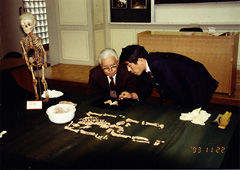
Click on the image to enlarge it. |
The excavated skeleton of the first Dederiyeh Neanderthal child.
When excavated, the bones were broken and in a very brittle state. The bowl at the left containes the skull. |
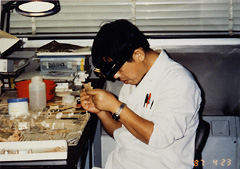
Click on the image to enlarge it. |
Rejoining the pieces of excavated bone.
After cleaning, the pieces of bone were glued together in a laboratory using a process of trial and error like a three-dimensional jigsaw puzzle. The rejoining of the top of the skull has been completed. The gaps between the bones were filled with paraffin. |
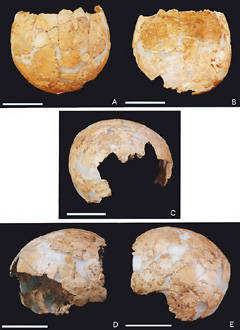
Click on the image to enlarge it. |
Cranial vault of the first Dederiyeh Neanderthal child (Dederiyeh 1).
The rejoining of the top of the skull has been completed. The gaps between the bones were filled with paraffin (from Dodo, Kondo, and Nara, 2003: Plate V-2). (Scale bar = 5 cm) |
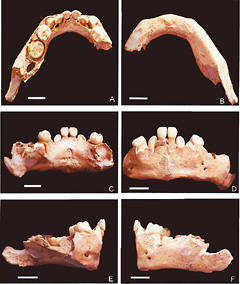
Click on the image to enlarge it. |
Reconstructed mandibular body of the first Dederiyeh Neanderthal child(Dederiyeh 1).
(From Dodo, Kondo, and Nara, 2003: Plate V-6.) (Scale bar = 1 cm) |
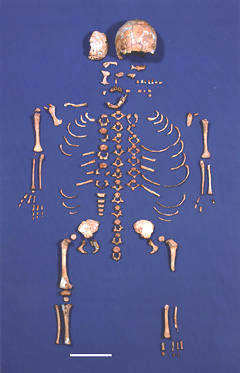
Click on the image to enlarge it. |
The complete skeleton of the first Dederiyeh Neanderthal child skeleton(Dederiyeh 1).
When excavated, the bones were broken and in a very brittle state. The anthropologists used various chemicals to harden these bones and then gradually began to rejoin them. In this way, almost all of the approximately 200 bones that make up the human body were reconstructed.
With the exception of the damaged facial skeleton, many other bones of the skeleton are well preserved. The bones of the spine are arranged into three rows. On the right are seven cervical vertebrae, in the center the twelve thoracic vertebrae, and on the right five lumbar vertebrae and the as yet unfused sacrum. The Dederiyeh find is still a child, so the body and arch of the vertebrae, the central sacrum, and the left and right innominate bones making up the pelvis have not yet fused. The childŐs height is thought to have been about 80cm. From the teeth eruption pattern, age is estimated at two years. At this age, clear sexual characteristics have not yet developed in the skeleton, and it is difficult to tell whether the child was a boy or a girl (from Akazawa and Muhesen (eds.), 2003: Frontispiece 1).
(Reconstruction by Y. Dodo and O. Kondo)
(Scale bar = 10 cm) |
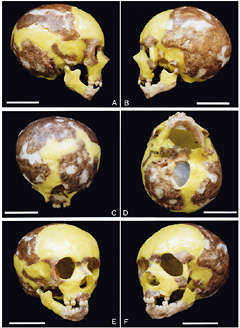
Click on the image to enlarge it. |
Reconstructed skull of the first Dederiyeh Neanderthal child (Dederiyeh 1).
The gaps between the bones were filled with paraffin (from Dodo, Kondo, and Nara, 2003: Plate V-1). (Scale bar = 5 cm) |
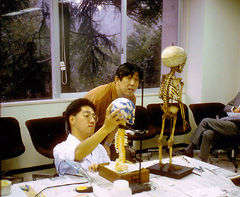
Click on the image to enlarge it. |
Reconstructing the upright skeleton of the first Dederiyeh Neanderthal child (Dederiyeh 1).
(From Akazawa and Muhesen (eds.), 2003, p. 337.) |
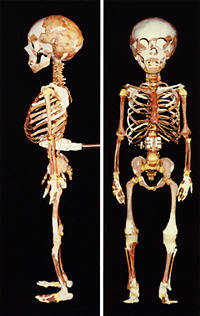
Click on the image to enlarge it. |
The completed skeleton of the sirst Dederiyeh Neanderthal child (Dederiyeh 1).
Using laser stereo lithography to produce the missing parts, a model was made of the whole skeleton. Stature is about 80 cm. From the eruption pattern of the teeth (which are all milk teeth), the age is estimated at about two years. Clear sexual characteristics have not yet developed in the skeleton, and it is unclear whether the child was a boy or a girl. Compared with modern infants, the following characteristics are noticeable:
- Overall proportions : large head; large bones
- Face : nasal bone is extremely large; chin projection is weak; outline of the eye sockets is circular
- Head : large and wide; outline is circular when viewed from behind
- Pelvis : pubis is large
(From Akazawa and Muhesen (eds.), 2003: Frontispiece 11.) | |







